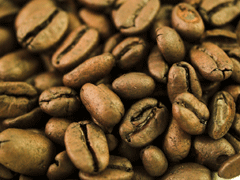Genetically Modified Joe
Air Date: Week of July 11, 2008

(Photo: Nat Hansen)
One day soon, coffee beans might be grown free of caffeine. One biotech company hopes to genetically modify the plant so that the beans won’t need to be stripped of caffeine, because they won’t be making it to begin with. "The DNA Files" producer Julie Grant reports.
Transcript
GELLERMAN: Soybeans aren’t the only thing grown in Brazil.
[MUSIC: Frank Sinatra “Coffee Song” from a You Tube video]
GELLERMAN: And it’s fair to say not one of those billions of beans is decaf - at least not ‘til it’s processed. But a small biotech company hopes to change that. It’s developing a coffee bean that has no caffeine. In a story originally produced for the radio project The DNA files, Julie Grant wakes up and smells the coffee.

(Photo: Nat Hansen)
RIVERA: We're going to talk about what goes on with roasting…
GRANT: Joseph Rivera is director of science and technology for the Coffee Association. He's teaching a class in decaffeination. Here's how it works. The green beans are steamed to soften and swell them. Then they're mixed in big stainless steel chambers with solvents.
RIVERA: It's just kind of a big laundry mat, if you will. Things are being
mixed up and swirled around.
GRANT: During all of that swirling, the caffeine molecules separate from the beans and attach to the solvents. They're siphoned out of the chamber, and what's left inside are the decaffeinated beans.
RIVERA: You have to realize that these beans have gone through a lot. They've been stressed out. They've been steamed. They've been beat up in these containers. They've been subjected to chemicals.
GRANT: Rivera says the chemical used in 60% of coffee decaffeinated in the U.S. is methylene chloride, the same stuff used in paint strippers and degreasers.
RIVERA: People don't like to hear that. [laughs] They don't like to hear that it's in paint remover. It's used in a number of different things.
GRANT: And Rivera says there's no denying that once you change the chemical make-up of the beans like this, you change the flavor of the coffee. That's where one scientist walking around the coffee conference sees his opening.
STILES: I'm John Stiles. I'm chief scientific officer for Integrated Coffee
Technologies.
GRANT: What is Integrated Coffee Technologies?
STILES: We're a small - I guess you'd say a boutique biotechnology company - that focuses on coffee and a few other tropical crops.
GRANT: Stiles says he prefers regular coffee to the decaf on the market today, including the decaf that's processed with water.
STILES: There's some really good methods for decaffeinating coffee now, but all of them change the flavor. There's no method that can take out just caffeine. You're never going to have the full flavor we all really love about really good coffee using a chemical process to take out the caffeine. Our approach--well, let's just not make caffeine, have everything else the same.

Genetically modifying coffee beans could eliminate the need to strip beans of caffeine. (Photo: Brian Lary)
STILES: We take the gene, and sort of turn it around backwards, and make it work in reverse.
GRANT: Normally, that caffeine-making gene sends out what's called messenger RNA, which goes from the nucleus into the body of the cell. There it's translated into the key enzyme that starts the caffeine making process. Flipping the gene around stops the process.
STILES: And so the enzyme doesn't get made. No enzyme, it can't do that first step, so no caffeine can be made.
GRANT: Stiles hopes to plant his decaf coffee trees in the field next year, and that's the next step in getting them approved for market. I'm Julie Grant.
GELLERMAN: Our story about decaf coffee beans is served up courtesy of SoundVision Productions in Berkeley, CA.
Living on Earth wants to hear from you!
Living on Earth
62 Calef Highway, Suite 212
Lee, NH 03861
Telephone: 617-287-4121
E-mail: comments@loe.org
Newsletter [Click here]
Donate to Living on Earth!
Living on Earth is an independent media program and relies entirely on contributions from listeners and institutions supporting public service. Please donate now to preserve an independent environmental voice.
NewsletterLiving on Earth offers a weekly delivery of the show's rundown to your mailbox. Sign up for our newsletter today!
 Sailors For The Sea: Be the change you want to sea.
Sailors For The Sea: Be the change you want to sea.
 The Grantham Foundation for the Protection of the Environment: Committed to protecting and improving the health of the global environment.
The Grantham Foundation for the Protection of the Environment: Committed to protecting and improving the health of the global environment.
 Contribute to Living on Earth and receive, as our gift to you, an archival print of one of Mark Seth Lender's extraordinary wildlife photographs. Follow the link to see Mark's current collection of photographs.
Contribute to Living on Earth and receive, as our gift to you, an archival print of one of Mark Seth Lender's extraordinary wildlife photographs. Follow the link to see Mark's current collection of photographs.
 Buy a signed copy of Mark Seth Lender's book Smeagull the Seagull & support Living on Earth
Buy a signed copy of Mark Seth Lender's book Smeagull the Seagull & support Living on Earth

